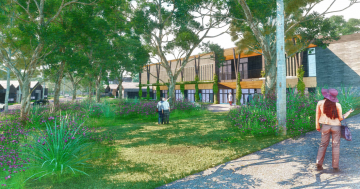
Zapari’s second proposal will be scaled back more as part of the deal struck with ACTPLA. Images: Supplied.
The ACT Planning and Land Authority (ACTPLA) has rejected claims that it’s a toothless body unwilling to fight for its decisions in the courts after the latest challenge to an ACTPLA ruling resulted in a deal that will see 140 apartments built on a Coombs site that originally only allowed a maximum of 44 apartments.
The first proposal from developer Zapari was for an eight-storey, 212-apartment development on the corner of John Gorton Drive and Terry Connolly Avenue but this was rejected, as was a scaled-back version of seven storeys and 149 apartments, with floor area more than halved and setbacks and green space increased.
ACTPLA cited overdevelopment, poor design, overshadowing and privacy implications for neighbouring residences when it knocked back the proposals, prompting Zapari to go to the ACT Civil and Administrative Tribunal (ACAT), much like POD Projects had done with its apartment block development also in Coombs.
As with POD, ACTPLA went into mediation with Zapari and has cut a deal to accept another revised proposal, including a lease variation to allow the 140 apartments.
Deputy Director-General, Sustainability and the Built Environment Geoffrey Rutledge said that once the matter was referred to ACAT, ACTPLA was no longer a decision-maker but a respondent with a duty to assist the tribunal, including entering into mediation.
“After considering the revised design proposed by the applicant, the three parties (Zapari, the Planning and Land Authority, and the Weston Creek Community Council) reached agreement on a revised proposal subject to a range of conditions,” Mr Rutledge said.
Zapari’s new plans include further reducing the building size and making improvements to the façade and amenity for units, cutting the number of apartments back to 140, a gradual reduction of the building height from six levels to four on the northern side, an increased curvature to the façade and various other details to improve the outcome and amenity of the proposed development.
“The Planning and Land Authority is of the view that the revised proposal, with the conditions imposed with the consent of the Tribunal, will be an approvable development having regard to the locality and RZ5 High Density Residential zoning of the site,” Mr Rutledge said.
“The conditions imposed by the Tribunal impose further protections to retain design elements that are critical to the outcome, and to ensure that the Weston Creek Community Council is advised in a timely way and involved in future amendments to the development.”
Mr Rutledge defended ACTPLA’s record in ACAT, saying that during the last financial year, the Tribunal upheld its original decisions for 88 per cent of matters that proceeded to hearings.
“The planning and land authority will only agree to resolution through mediation if the reasons for refusal are appropriately addressed, if any revised proposal is approvable under the Planning and Development Act 2007 and if the revised proposal represents an acceptable development outcome for the location,” he said.

ACTPLA went into mediation with Zapari and has cut a deal to accept another revised proposal.
Community activist Ryan Hemsley remained disappointed that ACTPLA was seemingly unable to stop developments that, in its own words, deviate significantly enough from both the intentions of the estate development plan and the maximum dwelling numbers specified in the site’s crown lease to warrant refusal.
“I understand that the planning laws allow developers to vary the development restrictions of crown leases, and that such lease variations are not uncommon,” he said. “However, I firmly believe that there is a material difference between a development that seeks to increase the maximum dwelling number by 25 per cent, and one that seeks to increase that number by over 200 per cent.”
“The ongoing approval of these kinds of developments will have significant consequences for the ability of the ACT Government to ensure orderly development in greenfield locations using crown lease provisions.”
Mr Hemsley said residents who lived near sites earmarked for multi-unit development would now have much less certainty about the type and density of building they could expect to be built on that site.
“I understand that the intent behind permitting lease variations is to encourage development in the ACT. However, I think the question needs to be asked: should this desire to encourage development be accommodated at the expense of buyer certainty and the ability of government to achieve desired development outcomes?”
Mr Hemsley said the government’s approach of approving ad-hoc lease variations risked a potential oversupply of units in the ACT, which may in turn impact on revenue from land sales.
He said the government appeared selective about which sites were worthy of protection from overdevelopment, evidenced by mandatory and enforceable restrictions on dwelling numbers in places such as the old Downer school site.
“While we couldn’t stop these developments from being approved, we did secure concessions that meant they ended up being less damaging than the original proposals. We need to ensure that these recent approvals are not seen as a green light for developers to lodge equally inappropriate development applications in the future,” Mr Hemsley said.



















